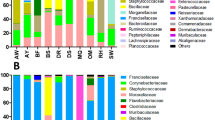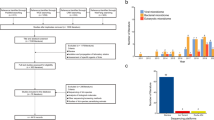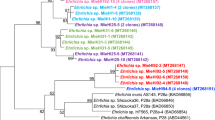Abstract
Ticks (order Ixodida) vector pathogenic bacteria that cause diseases in humans and other mammals. They also contain bacteria that are closely related to pathogens but function as endosymbionts that provide nutrients that are missing from mammalian blood—their sole food source. For instance, mammalian pathogens such as Coxiella burnetii and Francisella tularensis, as well as Coxiella-like and Francisella-like endosymbionts (CLEs and FLEs, respectively) occur in ticks worldwide. However, it is not clear whether the pathogens evolved from symbionts or symbionts from pathogens. Recent studies have indicated that C. burnetii likely originated from a tick-associated ancestor, but the origins of FLEs are not clear. In this study, we sequenced the genome of an FLE, termed FLE-Am, present in the Gulf Coast tick, Amblyomma maculatum. We show that FLE-Am likely evolved from a pathogenic strain of Francisella, indicating that tick endosymbionts can evolve from mammalian pathogens. Although the genome of FLE-Am is almost the same size as the genomes of pathogenic Francisella strains, about one-third of its protein-coding genes contain inactivating mutations. The relatively low coding capacity and extensive metabolic capabilities indicate that FLE-Am transitioned recently to its current endosymbiotic lifestyle and likely replaced an ancient endosymbiont with degraded functionality.
Similar content being viewed by others
Introduction
Blood is the sole source of nutrition for ticks; however, it contains minimal amounts of several amino acids and cofactors required for normal development1. Similar to insects that thrive on unbalanced plant diets2, ticks depend on symbiotic bacteria such as Coxiella-like and Francisella-like endosymbionts (CLE and FLE, respectively) that likely provision nutrients missing from their diet3,4. In addition to containing endosymbionts, ticks often vector closely related mammalian pathogens, including Francisella tularensis and Coxiella burnetii5,6, but the evolutionary relationship between the two clades is not clear. Among Amblyomma species (hard-backed tick, family Ixodidae), the most prevalent endosymbionts are CLEs, which have reduced genomes, a feature associated with long-term endosymbiosis7. Interestingly, unlike most other Amblyomma species, the primary endosymbiont of A. maculatum (Gulf Coast tick) is a FLE, termed FLE-Am8. We sequenced its genome and show that it likely evolved from a pathogenic ancestor, thereby showing that tick endosymbionts could evolve from mammalian pathogens. Unlike the highly reduced genomes of CLEs, FLE-Am has undergone minimal genome reduction, but a substantial number of its protein-coding genes, including virulence genes, contain inactivating mutations. This low coding capacity indicates that the endosymbiont originated recently and additionally, by virtue of its superior metabolic and biosynthetic capabilities, FLE-Am most likely replaced an ancestral CLE with degraded functionality, thereby allowing A. maculatum to escape the “symbiosis rabbit hole”9.
Results and Discussion
FLE-AM evolved from a pathogenic ancestor
We analyzed the A. maculatum microbiome and discovered that FLE-Am dominates the tick microbiome. Out of the 4,603 (>1 kb) contigs assembled from the sequencing reads, a vast majority was of host origin. Only 48 contigs were of bacterial origin and out of those 46 belonged to Francisellacae (Supplementary Table S1). FLE-Am has been previously shown to be the major bacterium present in A. maculatum8 and FLEs are maternally transmitted10, indicating that it is essential to the normal development of A. maculatum. We estimated the phylogenetic position of FLE-Am using 442 orthologous proteins present in 44 fully sequenced Francisella genomes. As shown in Fig. 1, FLE-Am shares a recent common ancestor with Francisella species that are pathogenic to mammals, with the exclusion of aquatic Francisella species that are pathogenic to fish. Our multi-protein tree clarifies earlier phylogenetic trees based on partial FLE-Am 16S rRNA sequences that showed it to be a sister taxon of F. tularensis11.
Virulence genes have been inactivated in FLE-AM
As shown recently for C. burnetii, mammalian pathogens could evolve from non-pathogenic ancestors by acquiring virulence genes12; conversely, avirulent symbionts could arise from pathogenic ancestors by losing virulence genes, but no clear examples of this process have been documented. To identify the evolutionary relationship between pathogenic Francisella and FLE-Am, we examined the FLE-Am genome for the presence of virulence genes described in F. tularensis and F. novicida13,14. We discovered that FLE-Am contained pseudogenized versions of several virulence genes, including genes for a Type VI Secretion System present on a pathogenicity island in F. tularensis and for Type 4 pili that are critical to mammalian infection (Fig. 2, Supplementary Table S2). Collectively, our data denotes that the ancestor of FLE-Am was most likely a mammalian pathogen that contained functional versions of virulence genes. The absence of intact secretion and effector gene systems in FLE-Am suggests that it is avirulent to humans despite its presence in the salivary glands and saliva of A. maculatum8. Intriguingly, salivary glands of other Amblyomma species such as A. americanum contain CLEs15. Although its functional significance is not understood, being secreted in saliva could facilitate the exchange of endosymbionts between ticks while co-feeding on the same host16.
Comparison of FLE-Am and F. tularensis genomes.
FLE-Am genome is on the right and F. tularensis tularensis SCHU-S4 genome is on the left. The outer two rings show protein-coding genes (blue in FLE-Am and green in F. tularensis). Rings 3 and 4 contain virulence genes (intact genes in orange and pseudogenes in black). Amino acid biosynthesis genes (green) are in ring 5. Cofactor synthesis and transport genes (purple) are in ring 6 and tRNAs (black) and rRNAs (red) are in ring 7. Sequencing read coverage for FLE-Am is shown in the innermost black semi-circle. Notice that the coverage for the rRNA operon is double that of the rest of the genome. The table in the center highlights the inactivation and loss of virulence genes in FLE-Am.
FLE-Am evolved recently and likely replaced an ancestral endosymbiont
The genome of FLE-Am (1.56 Mb) is ~80% the size of the genome of the mammalian pathogen F. tularensis (1.89 Mb) (Table 1) and a significant portion (~33%) of its protein-coding genes contains inactivating mutations (Fig. 2, Supplementary Dataset 1). The degree of reductive genome evolution in FLE-Am is much lower than what is usually observed in long-term endosymbionts such as a CLE in A. americanum (CLEAA)3 and the presence of large number of pseudogenes imply that the bacterium is in the initial stages of reductive evolution, as superfluous genes are first pseudogenized and then ultimately deleted from the genome when a bacterium shifts from a free-living to a host-associated lifestyle. Additionally, endosymbiont genomes tend to be much more A+T biased than closely related pathogens or environmental bacteria; however, the nucleotide composition (G+C%) of FLE-Am is very similar to that of F. tularensis (32. 3% and 31.8%, respectively)7,9. These features collectively indicate that FLE-Am transformed recently into an endosymbiont.
Because bacteria with extensive metabolic proficiency are known to replace ancient endosymbionts with reduced metabolic prowess9, we compared the metabolic pathways present in FLE-Am to that of CLEAA, the cofactor provisioning endosymbiont found in A. americanum3. As shown in Fig. 3, the metabolic capability of FLE-Am is much more extensive than in CLEAA. For instance, FLE-Am can produce heme in addition to cofactors (except thiamine) synthesized by CLEAA. Furthermore, while both FLE-Am and CLEAA share the ability to produce aspartate from pyruvate and to metabolize it into ATP, only the FLE synthesizes cysteine, threonine, tyrosine, tryptophan, phenylalanine and serine from pyruvate and can metabolize glutamate, glutamine and asparagine into ATP. Of these amino acids, FLE most crucially provides a reliable source of the amino acid cysteine, which is found in very low concentrations in bovine blood1. FLE-Am can also synthesize glutamine from glutamic acid and ammonia, thus recycling cellular ammonia waste to useful products. In sum, our data indicate that the superior biosynthetic capability of FLE-Am confers a selective advantage, which could have led to FLE-Am recently replacing an ancestral symbiont (e.g. CLE) with reduced metabolic capacity in A. maculatum.
Symbiosis with bacteria allows arthropods to thrive on nutrient-poor diets2. However, the absolute reliance on a symbiont could eventually become disadvantageous to the host because massive gene loss and accumulation of mildly deleterious mutations will corrode the symbiont’s metabolic capability7,9. One solution to escaping this symbiosis “rabbit hole” is to supplement or replace the ancient symbiont with new bacteria acquired from the environment9. This process has occurred in several lineages of insects (e.g. ref. 17). In A. maculatum, FLE-Am seems to have recently replaced an older endosymbiont, whose identity is unknown, but based on the current bacterial prevalence data it was most probably a CLE or a Rickettsia12. FLE-Am likely arose by the domestication of a mammalian pathogen that was vectored by the tick. This process could occur rapidly because the bacterium doesn’t have to learn anew how to circumvent the tick’s immune response and there is no need to attenuate bacterial virulence towards the tick18. Additionally, because genes that promote pathogenesis through amino acid scavenging (e.g., FTT 0968c, xasA), macrophage survival (e.g., carA, carB, bioF) and intracellular replication (aroE1, purMCD, purL and purF)13,14 are retained in FLE-Am (Fig. 1), they could be key to its endosymbiotic lifestyle. Further evolutionary, functional and genomic studies of FLEs and CLEs from a wide array of soft and hard ticks will help us to better understand how pathogenic Francisella evolved into endosymbionts that supports the blood-dependent lifestyle of ticks and how tick-associated Coxiella evolved into pathogenic C. burnetii12 (Fig. 4).
Methods
Sequencing and bacterial identification
DNA was extracted from a female A. maculatum procured from Oklahoma State University Tick Rearing Facility, as described previously3 and was sequenced using Illumina Hi-Seq 2500 (100 cycles, paired-end) at OHSU MPSSR, yielding approximately 180 million read pairs. Low confidence reads were removed and the identify of bacteria present in the tick microbiome were determined utilizing ≥1 kb contigs binned using MEGAN19.
Genome Assembly
Trimmed reads were assembled into contigs using IDBA-UD20 and by comparing them to Francisella genome sequences, FLE contigs were identified. All trimmed reads were mapped to these contigs and then reassembled with IDBA-UD and IDBA-hybrid into a final set of seven contigs (Supplementary Table S3), which were submitted to NCBI (Accession: LVCE00000000). The completeness of the assembled genome was examined using a single-copy gene database21 and as a control, an identical single-copy gene analysis was performed on F. tularensis subsp. tularensis SCHU S4 genome (NC_006570.2) (Table 1).
Genome Annotation
FLE-Am contigs were annotated using NCBI Prokaryotic Genome Annotation Pipeline and pseudogenes were verified manually. Protein-coding genes were binned into categories based on their role in primary metabolism, amino acid and nucleic acid synthesis, or vitamin and cofactor metabolism and then subsequently compared to CLEAA to illustrate differences in their metabolic capabilities. A list of genes critical to the pathogenicity of F. tularensis13,14 was used to identify both functional and pseudogenized versions of virulence genes present in FLE-Am (Supplementary Table S2). Intact protein-coding genes present in FLE-Am but not in F. tularensis SCHU-S4 are provided in Supplementary Table S4.
Phylogenetic Analysis
In addition to FLE-Am, we included all 44 fully sequenced Francisella genomes to generate a robust phylogenetic tree. Using reciprocal BLASTP, a subset of 442 orthologous genes (Supplementary Dataset 2) that were conserved in all genomes was identified. Nucleotide sequences were aligned using Clustal Omega22, ambiguously aligned regions were removed using Gblocks23 and jModelTest2 was used to select the GTR+I+G (General Time Reversible plus Invariant sites plus Gamma distribution) evolution model24. Using concatenated sequences, Maximum Likelihood trees with 1,000 bootstrap replicates were constructed using RAxML25. Bayesian trees with a chain length of 500,000 and a burn-in fraction of 25% and sampling every 100 trees were constructed using MrBayes26.
Additional Information
How to cite this article: Gerhart, J. G. et al. A Francisella-like endosymbiont in the Gulf Coast tick evolved from a mammalian pathogen. Sci. Rep. 6, 33670; doi: 10.1038/srep33670 (2016).
References
Duarte, R. T., Carvalho Simões, M. C. & Sgarbieri, V. C. Bovine blood components: fractionation, composition and nutritive value. J. Agri. c Food. Chem. 47, 231–236 (1999).
Baumann, P. Biology of bacteriocyte-associated endosymbionts of plant sap-sucking insects. Annu. Rev. Microbiol. 59, 155–189 (2005).
Smith, T. A., Driscoll, T., Gillespie, J. J. & Raghavan, R. A Coxiella-like endosymbiont is a potential vitamin source for the lone star tick. Genome Biol. Evol. 7, 831–838 (2015).
Ahantarig, A., Trinachartvanit, W., Baimai, V. & Grubhoffer, L. Hard ticks and their bacterial endosymbionts (or would be pathogens). Folia Microbiol. 58, 419–428 (2013).
Petersen, J. M., Mead, P. S. & Schriefer, M. E. Francisella tularensis: an arthropod-borne pathogen. Vet. Res. 40, 07 (2009).
Duron, O., Sidi-Boumedine, K., Rousset, E., Moutailler, S. & Jourdain, E. The Importance of Ticks in Q Fever Transmission: What Has (and Has Not) Been Demonstrated? Trends Parasitol. 31, 536–552 (2015).
McCutcheon, J. P. & Moran, N. A. Extreme genome reduction in symbiotic bacteria. Nat. Rev. Microbiol. 10, 13–26 (2012).
Budachetri, K. et al. An insight into the microbiome of the Amblyomma maculatum (Acari: Ixodidae). J. Med. Entomol. 51, 119–129 (2014).
Bennett, G. M. & Moran, N. A. Heritable symbiosis: The advantages and perils of an evolutionary rabbit hole. Proc. Natl. Acad. Sci. USA 112, 10169–10176 (2015).
Baldridge, G. D., Scoles, G. A., Burkhardt, N. Y., Schloeder, B., Kurtti, T. J. & Munderloh, U. G. Transovarial transmission of Francisella-like endosymbionts and Anaplasma phagocytophilum variants in Dermacentor albipictus (Acari: Ixodidae). J. Med. Entomol. 46, 625–632 (2009).
Sjödin, A. et al. Genome characterisation of the genus Francisella reveals insight into similar evolutionary paths in pathogens of mammals and fish. BMC Genomics 13, 268 (2012).
Duron, O. et al. The recent evolution of a maternally-inherited endosymbiont of ticks led to the emergence of the Q fever pathogen, Coxiella burnetii. Plos Pathog 11, e1004892 (2015).
Rowe, H. M. & Huntley, J. F. From the outside-in: the Francisella tularensis envelope and virulence. Front. Cell Infect. Microbiol. 5, 94 (2015).
Meibom, K. L. & Charbit, A. The unraveling panoply of Francisella tularensis virulence attributes. Curr. Opin. Microbiol. 13, 11–17 (2010).
Klyachko, O., Stein, B. D., Grindle, N., Clay, K. & Fuqua, C. Localization and visualization of a Coxiella-type symbiont within the lone star tick, Amblyomma americanum. Appl. Environ. Microbiol. 73, 6584–6594 (2007).
Wright, C. L., Sonenshine, D. E., Gaff, H. D. & Hynes, W. L. Rickettsia parkeri transmission to Amblyomma americanum by cofeeding with Amblyomma maculatum (Acari: Ixodidae) and potential for spillover. J. Med. Entomol. 52, 1090–1095 (2015).
Koga, R. & Moran, N. A. Swapping symbionts in spittlebugs: evolutionary replacement of a reduced genome symbiont. ISME J. 8, 1237–1246 (2014).
Clayton, A. L. et al. A novel human-infection-derived bacterium provides insights into the evolutionary origins of mutualistic insect-bacterial symbioses. Plos Genet. 8, e1002990 (2012).
Huson, D. H., Auch, A. F., Qi, J. & Schuster, S. C. MEGAN analysis of metagenomic data. Genome Res. 17, 377–386 (2007).
Peng, Y., Leung, H. C. M., Yiu, S. M. & Chin, F. Y. L. IDBA-UD: a de novo assembler for single-cell and metagenomic sequencing data with highly uneven depth. Bioinformatics 28, 1420–1428 (2012).
Albertsen, M., Hugenholtz, P., Skarshewski, A., Nielsen, K. L., Tyson, G. W. & Nielsen, P. H. Genome sequences of rare, uncultured bacteria obtained by differential coverage binning of multiple metagenomes. Nat. Biotechnol. 31, 533–538 (2013).
Sievers, F. et al. Fast, scalable generation of high-quality protein multiple sequence alignments using Clustal Omega. Mol. Syst. Biol. 7, 539–539 (2014).
Talavera, G. & Castresana, J. Improvement of phylogenies after removing divergent and ambiguously aligned blocks from protein sequence alignments. Syst. Biol. 56, 564–577 (2007).
Darriba, D., Taboada, G. L., Doallo, R. & Posada, D. jModelTest 2: more models, new heuristics and parallel computing. Nat. Methods. 9, 772 (2012).
Stamatakis, A. RAxML version 8: a tool for phylogenetic analysis and post-analysis of large phylogenies. Bioinformatics 30, 1312–1313 (2014).
Huelsenbeck, J. P. & Ronquist, F. MRBAYES: Bayesian inference of phylogenetic trees. Bioinformatics 17, 754–755 (2001).
Acknowledgements
We thank Colleen Campbell, Jess Millar, Todd Smith, Marie Baker and Jim Archuleta for technical assistance. This work was supported by Portland State University.
Author information
Authors and Affiliations
Contributions
J.G.G., A.S.M. and R.R. conducted the experiments, analyzed the data and prepared the manuscript.
Ethics declarations
Competing interests
The authors declare no competing financial interests.
Electronic supplementary material
Rights and permissions
This work is licensed under a Creative Commons Attribution 4.0 International License. The images or other third party material in this article are included in the article’s Creative Commons license, unless indicated otherwise in the credit line; if the material is not included under the Creative Commons license, users will need to obtain permission from the license holder to reproduce the material. To view a copy of this license, visit http://creativecommons.org/licenses/by/4.0/
About this article
Cite this article
Gerhart, J., Moses, A. & Raghavan, R. A Francisella-like endosymbiont in the Gulf Coast tick evolved from a mammalian pathogen. Sci Rep 6, 33670 (2016). https://doi.org/10.1038/srep33670
Received:
Accepted:
Published:
DOI: https://doi.org/10.1038/srep33670
This article is cited by
-
Decontamination protocols affect the internal microbiota of ticks
Parasites & Vectors (2023)
-
Novel Francisella-like endosymbiont and Anaplasma species from Amblyomma nodosum hosted by the anteater Tamandua Mexicana in Mexico
Experimental and Applied Acarology (2023)
-
Characterization of the bacterial microbiome of Amblyomma scalpturatum and Amblyomma ovale collected from Tapirus terrestris and Amblyomma sabanerae collected from Chelonoidis denticulata, Madre de Dios- Peru
BMC Microbiology (2022)
-
Bacteria related to tick-borne pathogen assemblages in Ornithodoros cf. hasei (Acari: Argasidae) and blood of the wild mammal hosts in the Orinoquia region, Colombia
Experimental and Applied Acarology (2022)
-
Ecological Contacts and Host Specificity Promote Replacement of Nutritional Endosymbionts in Ticks
Microbial Ecology (2022)
Comments
By submitting a comment you agree to abide by our Terms and Community Guidelines. If you find something abusive or that does not comply with our terms or guidelines please flag it as inappropriate.







